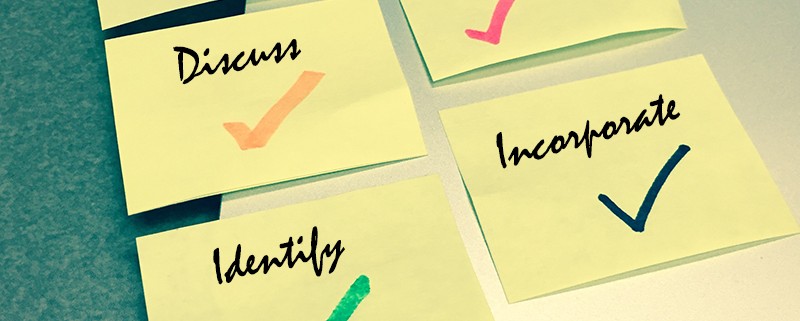Checklist to Improve the Small Business Employee Onboarding Process
Your business is agile, nimble…you’re capable of taking swift, decisive action in a short period of time. For example, it’s Thursday afternoon and your team has just finished interviewing the last of the final candidates for a newly-created job in your firm. You needed to fill the position yesterday. But, if all goes as planned, the offer will be extended yet today, the candidate (who seemed really excited) will accept on Friday, and…in the spirit of chaotic, yet productive startups, he will start work on Monday! He can just grab a notepad and some pens out of the supply closet, and do without a laptop for a few days (argh…we need to order that today) because he’ll just be shadowing other people during that time.
Sound familiar? Hopefully not, but don’t be ashamed if it is a sometimes accurate description of the employee onboarding process at your small business. It can be easy to ignore the importance of employee onboarding in the SMB space, especially if you happen to be growing like gangbusters, have a pretty good culture and perhaps many opportunities for upward movement across the organization. The thing is…those positive attributes are likely in play despite your lackluster onboarding process. Since your onboarding process is akin to your new hires’ first impression of your company, the business needs to put some effort and time into this new employee experience. The results of your efforts will exponentially improve your business.
Here’s a checklist a small organization may use to start talking about employee onboarding process change.
1 – Envision future success
There’s no point in initiating a change effort if you won’t recognize success when it finally happens. If you’re not sure where to start, consider your organization’s current definition of employee onboarding, and then think outside the box to include other items that are now commonly attributed to this effort by the modern HR practitioner.
Think about broad stroke adjectives that could be used to describe your future successful onboarding process. Do you want to make it more: special; professional; efficient; niche-focused; standardized; personalized; etc.? Pulling out some key themes will then allow you to brainstorm more detailed ideas.
It’s key to visualize success simply so that you actually know when you accomplish it someday. And certainly the journey is never over. Upon reaching your first milestone accomplishment you’ll want to create new success goals; however, you must know where you’ve been and where you are going first. That’s why it’s important to identify potential performance indicators, establish starting benchmarks, and then evaluate movement and impact over time to determine which metrics are the most influential to positive change. Stay tuned for more details on this in a future blog.
2 – Discuss planning considerations
Before embarking on the change effort, along with brainstorming ideas, it’s important to note constraints that may impact your re-engineering endeavors, as well. For example, identify potential obstacles such as:
- Availability of certain employees to participate in various steps of the onboarding process
- Any existing policies prohibiting certain activities within the organization (i.e. new hires can’t watch videos about company culture and training on YouTube if your company blocks that site from employee computers)
- Fulfillment time for provisioning employee equipment is set at a minimum number of days (no matter what)
- Lack of the availability of hiring software to facilitate electronic signatures and approvals and task notifications
Additionally, bear in mind that your approach will vary depending on whether your human resources function is centralized or decentralized. For example, in a centralized system, an organization with different locations will likely rely even more heavily on supervisors to carry out the majority of the tasks associated with pre-boarding and onboarding since HR staff won’t always be directly available.
The complexity of your business will of course drive the development of your new onboarding plan, too. If you have multiple divisions and/or departments, then it would be to your advantage to take time to customize different versions of your plan so they each include items specific to their respective department to better engage employees. These customizations will range from different statutory forms being required depending on employee location to different long-term training curriculum options being offered depending on employee role level.
As you plan the many elements of your revised employee onboarding process, continuously evaluate how the number of stages you choose to include impacts the overall length of your process. And remember, it’s not a bad thing to have a comprehensive onboarding process that lasts for a year or more; however, it is underwhelming to cram a bunch of information into a new employee’s first couple of days — particularly, if that’s all she wrote for the onboarding experience.
3 – Identify potential onboarding process players
Planning a stage in which you get buy-in from the stakeholders involved in your employee onboarding process is a critical port-of-call on your voyage to improvement. People will more likely be active (rather than adverse) participants in change that they help shape. So, at the onset of your project, think about people who have relationships with new hires, and then also consider how the scope of their relationships will impact the extent to which they should be involved in the project. Some will be champions for your cause; while others are sufficient as supporting cast members…but you do want to engage all at the appropriate level. Potential onboarding process players may include:
- newly hired employees
- human resources department members
- hiring managers / supervisors
- people that provision equipment / resources
- people that approve forms
- existing department members
- members of senior management
- mentors and buddies assigned to new employees
- external vendors who interface with a new hire’s role
- customers of your organization
Depending on both the individual as well as his/her role in the onboarding effort, different communication styles may be appropriate. Take time to mutually create expectations with others about communication preferences that will efficiently support the execution of the process.
4 – Build a framework for accountability
Where many small organizations fall down is in their tendency to repeatedly bandage their process gaps instead of making time for re-engineering efforts and strategy sessions. Their immediate pain is often getting product out the door in time, delivering service that is personalized, and other issues that arise from narrow staff bandwidth. Or, if they do have a periodic project retreat to discuss action steps, they may later fail to execute those items and stay on track to realize change.
The same macro-level tendencies of the organization are often recreated at the employee onboarding micro-level, as well. To overcome this pattern, it’s important for companies to specifically document their plan for change, assign tasks to specific individuals and set milestone deadlines for project completion so that the revamped onboarding process can be put into action for future new hires. Your initial approach may involve the eventual creation of a Gantt chart; however, if you’re a small business ready to foster team collaboration, using colored sticky notes at a team meeting can go a long way, too. Brainstorm all facets and tasks involved in the process, narrow down a sequential order and then assign stakeholders action items and responsibilities by adding initials to the sticky notes. The note color coding strategy can be applied in whichever way is most appropriate for your organization. Here are some ideas:
- task category (tactical vs. strategic vs. cultural?)
- task location within onboarding process timeframe (first week vs. six month anniversary)
- person responsible
- new onboarding process items vs. old process steps
- priority for completion (if process is being rolled out in multiple phases)
As you and your team hammer out the details, be sure and think about how employees’ task assignments and roles can affect their onboarding experience and adjust accordingly. For example, some tasks may be completed independently from one another; whereas, others require certain prerequisite items to be completed beforehand.
5 – Incorporate external feedback, tools and resources
It’s easy for small businesses to only consider how their existing resources might be altered to impact employee onboarding process change. However, SMBs do themselves a disservice if they assume that external resources may cost too much, take too much time to research/implement, or have too many bells and whistles for their needs. Here are a list of ideas that could further raise your employee onboarding process game:
- Survey stakeholders – While the HR team is accustomed to looking out for employees and striving to make improvements, they have only one perspective of what needs to change–their own perspective. By taking time to survey other players in the process who are external to HR, valuable ideas can be gained.
- Research other employers – If you admire any other organizations for their low turnover and ability to assimilate happy new employees, then make time to take some notes on how your organization can incorporate some of their best practices…or at least take their ideas and tweak them to fit your culture.
- Don’t forget the legalese – The more tactical side of employee onboarding includes the requisite paperwork and documents…some of which are required in order for the individual to be in your employ legally. The employment law landscape changes over time, and especially if you hire in different states and certain industries, being aware of the latest updates is essential to avoid big costs later. A trusted employment law attorney is someone you should have on speed dial.
- Make the most of employee assessments – A validated, job-relevant assessment tool, when embraced and used by the entire team, can dramatically improve a new hire’s productivity earlier in the employment relationship. Especially those assessments that have cognitive and behavioral elements…as they allow both new hire and manager to peer into one another’s hard-wiring right off the bat so that they can begin to work together effectively that much sooner. Scheduling onboarding sessions to discuss assessment tools and how they tell a story about one’s skills, motivations and/or preferences is time well spent.
- Reserve a spot for technology in your onboarding process – Especially because some software companies now focus on working with small- and medium-sized companies, many web-based tools now exist that are budget-friendly. Whether it be using social media to publicly welcome new employees to the firm, building in gamification activities to improve training activity retention rates, and/or implementing employee onboarding software to make your process paperless and improve accountability further into your onboarding process with the use of task assignments and notifications…the cost of tech resources is often insignificant when compared to the savings realized by the resulting improved productivity, lower turnover and quick access to web-based information.
If you’re committed to avoiding future next day new hire scenarios, then follow this small business employee onboarding checklist to be on your way to planning innovative change that will positively impact your organization.
ExactHire’s hiring software solutions are specifically designed for small- and medium-sized organizations. For more information on our employee onboarding software, please visit our resources section, try our pricing estimator tool and/or contact us today.











 15% OFF FULL-SERVICE HIRING • APPLICANT TRACKING SOFTWARE • ONBOARDING SOFTWARE
15% OFF FULL-SERVICE HIRING • APPLICANT TRACKING SOFTWARE • ONBOARDING SOFTWARE